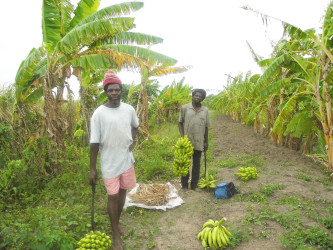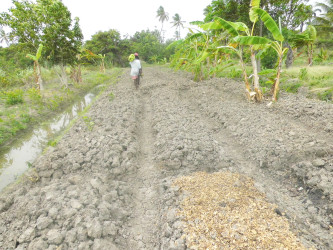The once thriving Buxton Market persists through episodes of community stigmatization and tragedy which the proud and prominent East Coast Demerara village has had to endure. Unsurprisingly, the economy of Buxton has suffered too. The Market is no longer the centre of trade that it once was.

It has become a ghostly space, its empty stalls serving as little more than reminders of better days, sentinels to a more prosperous time. But the Backdam, says Buxtonian Leroy Hamer, still thrives; it is still fertile land.
“We have good land here. Just give us a market and we will produce,” Hamer says. He says the community’s farmers are “holding back,” waiting for a suitable place to market their produce.
Hamer is one of three farmers whom Stabroek Business engaged recently and who talked about the trials facing the East Coast farming community. The challenges, he believes, derives from lack of opportunity rather than lack of effort.
Another farmer from the community, Ronald Roberts, told this newspaper that currently, the main outlets for Buxton’s farm produce are the vendors in the Bourda Market.
“It’s more convenient for us because if we had to sell ourselves we’d have to spend all day and even overnight in the market. You can’t farm if you selling so right now we does wholesale to the vendors there but when sales bad they can’t take you produce and you are left with it,” Roberts explained.
The farmers, however, say they are looking ahead to the realization of the various public pronouncements by President David Granger regarding the importance of reviving the village economy. “Strong village economies,” the President said at an August 2015 forum on the state of the African Guyanese, will, in turn, “make a strong national economy……….we need, as a country to explore opportunities for self-employment, entrepreneurship, and business. Every society in this world is defined by what it produces, is defined by the way it makes its living,” Granger said.
The present day reality is that the farmers of Buxton must, for the time being at least, depend on their own limited reach and on the promises of an expanded market held out by the New Guyana Marketing Corporation. At the end of the day, however, their livelihoods depend on their own efforts and on the as yet unfulfilled promises of a bigger market.

“Representatives from NAREI and GMC had a meeting with us a few weeks ago and the lady from GMC promise to work with us to find markets for watermelons but we ain’t hear from she since,” Vibert Hamer told Stabroek Business. It didn’t seem to be a matter of criticising the GMC but merely one of issuing a reminder of what so often appears to be the eternal plight of these farmers…waiting for something to happen.
Waiting, however, won’t cut it. There are mouths to feed, bills to pay and in the meantime an old minibus has been pressed into service as a mobile retail outlet for several cash crop farmers. It isn’t much but it will have to do.
With the bus, the farmers say, they are at least able to move their produce within the community and from one community to another. It beats sitting and hoping and waiting for help to come.
The farmers are at least able to take their produce to a market of sorts, to begin to allow their community to be defined by what it produces. It’s some distance from being enough but at least it’s a start…and the backdam soil is always fertile, always ready to produce.




